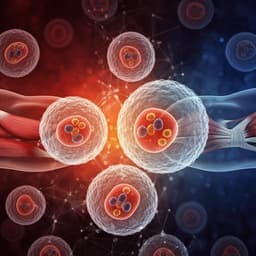
Medicine and Health
Plasticity of muscle synergies through fractionation and merging during development and training of human runners
V. C. K. Cheung, B. M. F. Cheung, et al.
This exciting research by Vincent C. K. Cheung, Ben M. F. Cheung, Janet H. Zhang, Zoe Y. S. Chan, Sophia C. W. Ha, Chao-Ying Chen, and Roy T. H. Cheung explores the evolution of locomotor synergies in running across different age groups and training levels. The study reveals how muscle coordination changes from childhood to elite marathoners, shedding light on the mechanisms of motor development and efficiency in running.
~3 min • Beginner • English
Introduction
The study investigates how neural constraints underlying locomotor control adapt across the lifespan and with training. Although modular motor primitives appear inborn or established early, changes in biomechanical properties during development and task demands during learning require the CNS to adjust coordination. Running is an ideal model: children and adults can run without formal training, yet biomechanics differ markedly across ages, and performance running requires training to optimize economy. The research question is how muscle synergies for running reorganize from preschool age to adulthood and with progressive running experience, and whether specific changes relate to running efficiency.
Literature Review
Prior work suggests motor commands are constrained by modular neural architectures (motor modules/primitives) that facilitate coordination. Some modules are inborn or determined early and remain invariant across lifespan or species, yet data also indicate that motor development and acquisition of difficult skills involve either new modules or modification of existing ones. Spinal premotor interneurons and motor cortex co-activate muscle groups implementing biomechanical functions. NMF-derived muscle synergies from EMG align with spinal interneuronal network organization. Running/walking synergies and their speed dependencies have been described, and training or pathology can alter modular structure, including merging after stroke. These findings motivate examining whether development drives fractionation of early synergies and training drives merging to refine adult motor patterns.
Methodology
Design and participants: Cross-sectional and longitudinal study across 5 groups: preschoolers (n=10, age 3–6), sedentary adults (n=9), novice runners (n=14; baseline, 3 and 6 months into training), experienced runners (n=15), and elite runners (n=15; sub-3 h marathoners). Total 63 subjects assessed over >100 sessions. Right leg dominance in all. Ethics approval obtained; informed consent provided.
Task and recordings: Preschoolers ran over-ground at self-selected speed; adults ran on an instrumented treadmill at self-selected preferred speed for 2 min. Longitudinal sessions (sedentary at 0 and 2 months; novice at 0, 3, 6 months) were performed at the same speed as baseline. Kinematics captured at 200 Hz; ground reaction forces (GRF) at 1000 Hz for adults (treadmill-embedded force plates). Preschooler force data deemed insufficient for reliable GRF; not used.
EMG acquisition and preprocessing: Surface EMG from 15 right-sided trunk and lower-limb muscles (Latissimus dorsi, External oblique, Rectus abdominis, Erector spinae, Gluteus maximus, Tensor fasciae latae, Vastus medialis, Vastus lateralis, Rectus femoris, Biceps femoris, Tibialis anterior, Medial gastrocnemius, Lateral gastrocnemius, Soleus, Peroneus longus) sampled at 1000 Hz. EMG high-pass FIR 50 Hz, rectified, low-pass FIR 20 Hz, integrated at 20 ms intervals, artifacts removed by inspection, and each muscle normalized to unit variance.
Synergy extraction: Non-negative matrix factorization (NMF) decomposed EMG D(t) into time-invariant muscle synergy vectors (W) and time-varying activation coefficients (C(t)). For each session, 1–15 synergies were extracted with 20 random initializations; the solution with highest reconstruction R^2 selected. The number of synergies N_syn chosen as minimum achieving ~80% EMG reconstruction R^2. Iterations stopped when change in R^2 < 0.001% for 20 consecutive iterations.
Clustering and similarity: Within each group, synergy vectors were clustered using k-means (squared-Euclidean, 1000 replicates). The number of clusters determined by the gap statistic (reference sets N=500; criterion Gap(k) ≥ Gap(k+1) − sd(k+1)). Subject-invariant clusters were those with contributions from ≥1/3 of subjects. Between-group similarity quantified by scalar product (SP) between normalized cluster centroids (SP ≥ 0.8 considered well matched). Component-wise differences tested by t-test.
Sparseness: Synergy-vector sparseness quantified (range 0 to 1; 1 = single-component vector, 0 = uniform) and averaged per subject and group.
Merging and fractionation analyses: Merging modeled as a non-negative linear combination of synergies from a basis group (primarily Sedentary 0 mo), identifying instances where an adult synergy could be reconstructed by merging ≥2 basis synergies with non-negative least squares (each coefficient ≥0.2) and SP ≥ 0.8 with the target. Fractionation modeled conversely: preschooler synergy reconstructed by non-negative linear combination of multiple Sedentary 0 mo synergies. Two levels of analysis were used: centroid-to-centroid and exhaustive subject-pair reconstructions to catalogue unique merging/fractionation combinations by cluster membership. A Merging Index (MI) was defined per subject as the percentage of that subject’s synergies explainable by merging Sedentary 0 mo synergies.
Temporal coefficient analysis: For detected merging instances, C(t) segments were stride-aligned, resampled to 1000 points, averaged per cycle, normalized, and modeled as a non-negative combination of the to-be-merged C(t)’s to test whether one original C(t) dominated (largest coefficient percentage) or multiple contributed equally (ANOVA/Kruskal-Wallis across coefficients).
Running energetics and efficiency: For adults, vertical center-of-mass (CoM) displacement derived by double integrating vertical CoM acceleration (from VGRF and body mass), assuming zero mean velocity per stride. VGRF vs CoM displacement hysteresis loop area estimated vertical-direction energy loss per cycle, normalized by body mass, and extrapolated to 30-min running. A regression (sedentary + experienced adults) of body-height-normalized preferred speed vs 30-min energy loss defined expected loss; each subject’s running efficiency was the vertical deviation below this line (kJ/kg). Efficiency compared between subjects with vs without specific merging combinations.
Statistics: Two-sample t-tests or Mann-Whitney U tests; ANOVA or Kruskal-Wallis with Tukey-Kramer post hoc; repeated-measures ANOVA or Friedman for novices; Pearson correlations for trends across groups. Significance at 0.05.
Key Findings
- Developmental fractionation: Preschoolers required fewer synergies than sedentary adults to reach ~80% reconstruction (≈6 vs ≈7; p=0.010). Sedentary synergies were significantly sparser than preschoolers (p=0.0018). Of 7 subject-invariant preschooler clusters and 11 sedentary clusters, 6 cluster pairs matched with SP ≥ 0.87, while 5 sedentary clusters were unmatched and tended to include 1–2 active muscles. Modeling indicated three preschooler extensor-related clusters (P-4, P-5, P-6) were fractionated into six sedentary clusters (e.g., TA-only SO-7, and TFL+GLUT SO-8), with reconstructions SP 0.93–0.99.
- Training-related merging: Across adults from Sedentary to Elite, the number of synergies decreased (~7 to ~6; Kruskal-Wallis p=0.0058 with post hoc significant pairs) and sparseness decreased (Kruskal-Wallis p=0.0003), indicating more muscles active per synergy with experience. The Merging Index (MI) increased progressively from Sedentary to Novice/Experienced/Elite (ANOVA p=0.0003) and changed significantly over novice training (rm-ANOVA p=0.037), consistent with merging during training. Sedentary synergies generalized best to other groups’ EMG (cross-fitting; supplementary).
- Efficiency-enhancing merging combinations (adults): Three combinations were associated with higher running efficiency in subjects who possessed them: SO-7+11 (Wi n=18 vs Wo n=72; p=0.049), SO-5+6+12 (Wi n=17 vs Wo n=73; p=0.011), SO-5+6+8 (Wi n=34 vs Wo n=56; p=0.028). Their frequencies increased with experience (correlations across adults r=0.83–0.90; p ≤ 0.021).
- Efficiency-reducing merging combinations: SO-3+12 associated with lower efficiency across all adults (Wi n=9 vs Wo n=81; p=0.042) and was more prevalent in less-experienced groups (negative trend r≈ -0.72). SO-4+5+7 associated with lower efficiency in experienced and elite (Wi n=6 vs Wo n=24; p=0.016); notably prevalent in Experienced group.
- Combined effects: Highest efficiencies occurred when efficiency-enhancing combinations (E1: SO-7+11; E2: SO-5+6+8 or SO-5+6+12) were present and efficiency-reducing patterns (R1: SO-3+12; R2: SO-4+5+7) were absent. Presence of R patterns suppressed efficiency even when E patterns were present; absence of R without E yielded only modest, often non-significant gains.
- Temporal mechanism: In 7 of 10 prevalent Elite merging combinations, the merged C(t) was dominated by one to-be-merged synergy’s C(t) (largest coefficient 78–99% of total), supporting a mechanism where multiple W-encoding networks become synchronously driven by a single original oscillator.
- Additional observations: Preferred speed correlated weakly with synergy metrics across groups (r≈0.20–0.36) and not within groups, suggesting speed is not the sole driver of changes. Experienced runners showed unexpectedly lower efficiency, coinciding with higher prevalence of the efficiency-reducing SO-4+5+7 pattern.
Discussion
Results indicate substantial plasticity of muscle synergies across development and training. During child-to-adult development, early synergies often involving broad co-contractions fractionate into sparser, more individuated units, likely reflecting maturation of neuromusculoskeletal properties and reduced need for co-contraction to ensure stability. Some preschooler synergies are eliminated or reorganized as limb biomechanics change. In adults, training sculpts synergies through merging, reducing dimensionality and restricting variability to task-relevant subspaces that enhance running economy. The presence of specific merging combinations correlates with improved efficiency (e.g., co-activation of plantarflexors, quadriceps, gluteus maximus, and TFL during stance; or coordination of dorsiflexors with latissimus dorsi suggesting arm–leg synchronization), whereas other combinations correlate with inefficiency (e.g., plantar- and dorsiflexor co-contraction at initial contact increasing stiffness and loading rate; trunk and gluteus co-activation perturbing arm swing). Analysis of temporal coefficients supports a neural mechanism whereby merging arises from reassigning multiple synergy-encoding interneuronal networks (W) to be driven by a single dominant oscillator (C). Although preferred speed varies with age and training, weak correlations and longitudinal novice results at fixed speed indicate speed alone does not explain the observed changes. The framework highlights how developmental outcomes constrain and enable adult learning: fractionated developmental synergies become building blocks for different, training-driven recombinations. Notably, inappropriate merging can degrade performance, as seen in the experienced group’s reduced efficiency linked to an efficiency-reducing pattern.
Conclusion
The study demonstrates complementary processes shaping human locomotor control: developmental fractionation of early, broad synergies into more specific units, and training-induced merging of pre-existing adult synergies into task-optimized modules. Specific merging patterns are associated with higher or lower running efficiency, and a dominant-oscillator temporal mechanism likely underpins merging. These findings suggest the CNS leverages and modifies existing modules rather than creating entirely new ones for skill acquisition, offering a framework to understand how development constrains adult motor learning and how training can both enhance and impede performance depending on the merging patterns acquired. Future work should examine interactions when training begins before adulthood, clarify speed dependencies across broader speed ranges, and explore interventions that promote efficiency-enhancing and suppress efficiency-reducing merging patterns.
Limitations
- Running speed confound: Preferred running speed varied across groups, and synergy measures correlated weakly with speed across groups, though not within groups; speed is not the sole determinant but remains a potential confound.
- Measurement modality differences: Preschoolers ran over-ground and adults on a treadmill; preschooler GRF data were insufficient for analysis, precluding computation of running efficiency in children and introducing potential modality differences.
- Efficiency metric approximation: Adult running efficiency was inferred from vertical-direction energy loss relative to a regression derived from sedentary and experienced adults; this is an indirect estimate, not a direct metabolic measure.
- Sample characteristics: Group sizes were modest; elite group was all male; novice training programs were self-selected and not standardized; experienced and elite groups were not followed longitudinally.
- Observational associations: Identified merging patterns correlate with efficiency but do not establish causality; unmeasured factors may contribute.
Related Publications
Explore these studies to deepen your understanding of the subject.







